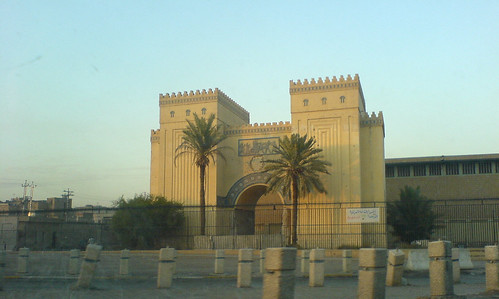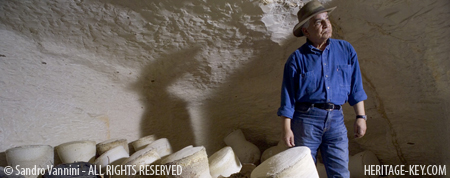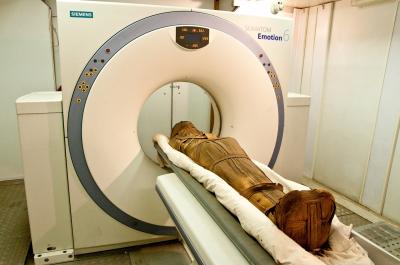 Get up from your chair, take a step back and watch this video by the AGO attentively, as you’re going to learn how to ‘tut’. Inspired by ancient Egyptian art work ‘tutting’ isn’t that far off from walking like an Egyptian, but on a different tune.
Get up from your chair, take a step back and watch this video by the AGO attentively, as you’re going to learn how to ‘tut’. Inspired by ancient Egyptian art work ‘tutting’ isn’t that far off from walking like an Egyptian, but on a different tune.
In a video posted to their website to promote the ‘King Tut:The Golden King and the Great Pharaohs‘ exhibition, the the Art Gallery of Ontario is teaching the internet crowd how to dance like an Egyptian. The instructional clip features Mark Cabuena demonstrating a basic ‘tutting’ routine that is easy – yeah, right – and fun – to watch others try – to learn.
The ‘tutting’ moves are based on a 1980s – Tutankhamen frenzy inspired – ‘King Tut’ comedy dance routine performed by Steve Martin and the The Toot Uncommons (back then quite a big hit). Now Cabuena has choreographed a special ‘tutting’ routine for you to learn which you can demonstrate at the local Christmas Fair after a moderate consumption of Gluhwein – really, ‘mulled wine’?!
The Art Gallery of Ontario’s ‘How to Tut’ Tutorial
If you after those – probably not that successful – first attempts at tutting you just can’t get enough – and keep getting better – consider joining the Art Gallery of Ontario on Sunday the 28th of February 2010, when they are hosting their ‘Tutting Day’ and go setting a world record in the category ‘Tut and 90 degree angles’.
I’d say “Kids and Egyptomaniacs, do try this at home, but remember:not all joints are made for a 90 degrees movements and isolating your arms from the rest of your body does _not_ mean dismemberment.” I am definitely looking forward to children and adults alike putting their tutting ‘home movies’ on YouTube and even better… imagine tuttin’ lolcats!
For more information on the Tutting Day and world record event, keep an eye on www.ago.net/tutting and Heritage Key. And of course, feel free to share your own tutting-practise videos with us!


 When Asked if the Internet search giant was planning any other projects in Iraq, Schmidt replied: “We’ve started with this one, I’m sure we’ll add more.”
When Asked if the Internet search giant was planning any other projects in Iraq, Schmidt replied: “We’ve started with this one, I’m sure we’ll add more.” Archaeologists from USC, UCLA and the Middle East have developed a searchable online map that details 7,000 archeological sites on the West Bank and Jerusalem – many of them never publicy disclosed. The map – an effort to identify Israeli archaeological activity since 1967, when Israel took over the West Bank and East Jerusalem – is freely accesibly online at the USC’s Digital Library.
Archaeologists from USC, UCLA and the Middle East have developed a searchable online map that details 7,000 archeological sites on the West Bank and Jerusalem – many of them never publicy disclosed. The map – an effort to identify Israeli archaeological activity since 1967, when Israel took over the West Bank and East Jerusalem – is freely accesibly online at the USC’s Digital Library. Government agencies could consult the database before planning roads or other public works projects.
Government agencies could consult the database before planning roads or other public works projects. Have you always wished to meet Dr. Hawass in person? Now is your chance!The world-famous archaeologist comes to London in December and Heritage World Press invites you to a special lecture by the Egyptologist – and maybe even dinner. Zahi Hawass will also introduce his two new books: Inside the Egyptian Museum and A Secret Voyage.
Have you always wished to meet Dr. Hawass in person? Now is your chance!The world-famous archaeologist comes to London in December and Heritage World Press invites you to a special lecture by the Egyptologist – and maybe even dinner. Zahi Hawass will also introduce his two new books: Inside the Egyptian Museum and A Secret Voyage. Jean-Franois Dumon and Alamanga have developed ‘Aaou’, an application for iPhone and iPodTouch which allows a quick translation of hieroglyphs. The iPhone app over 10,000 words or symbols to – depending on your iPhone settings – French or English. the translation in French / English of more than 10200 words and symbols and offers the possiblity of transliteration. ‘Aaou’ also allows you access through an index, to the uni/bi/triliterals as well as to an aide memory on the common hieroglyphs. The Aaou Hieroglyph Dictionary is priced at 4.99 euro and – of course – available via the iTunes app store.
Jean-Franois Dumon and Alamanga have developed ‘Aaou’, an application for iPhone and iPodTouch which allows a quick translation of hieroglyphs. The iPhone app over 10,000 words or symbols to – depending on your iPhone settings – French or English. the translation in French / English of more than 10200 words and symbols and offers the possiblity of transliteration. ‘Aaou’ also allows you access through an index, to the uni/bi/triliterals as well as to an aide memory on the common hieroglyphs. The Aaou Hieroglyph Dictionary is priced at 4.99 euro and – of course – available via the iTunes app store. Scientists discoveredthat the ancient Egyptians suffered from – what we often consider to be modern day – heart diseases too. Hardening of the arteries has been detected in Egyptian mummies, some as old as 3,500 years, suggesting that the factors causing heart attack and stroke are not only modern ones; they afflicted ancient people, too.
Scientists discoveredthat the ancient Egyptians suffered from – what we often consider to be modern day – heart diseases too. Hardening of the arteries has been detected in Egyptian mummies, some as old as 3,500 years, suggesting that the factors causing heart attack and stroke are not only modern ones; they afflicted ancient people, too. The most ancient Egyptian afflicted with atherosclerosis was Lady Rai, who lived to an estimated age of 30 to 40 years around 1530 BC and had been the nursemaid to Queen Ahmose Nefertiri. To put this in context, Lady Rai lived about 300 years prior to the time of Moses and 200 prior to
The most ancient Egyptian afflicted with atherosclerosis was Lady Rai, who lived to an estimated age of 30 to 40 years around 1530 BC and had been the nursemaid to Queen Ahmose Nefertiri. To put this in context, Lady Rai lived about 300 years prior to the time of Moses and 200 prior to 
